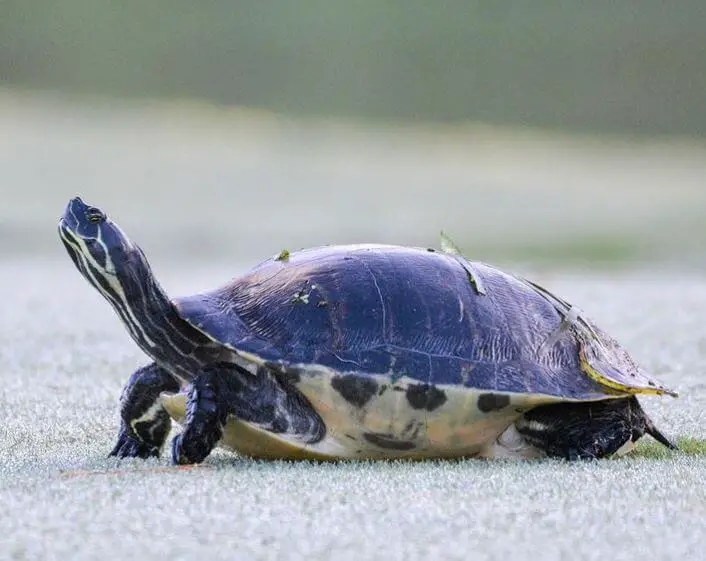How many watts for turtle basking are needed?
We all know that turtles bask in the sun to keep their body temperature up, but did you know this is one of the reasons why they are so slow?
Turtles need a lot of energy to stay warm, and since basking helps them do just that, then it’s something that they spend most of their time doing.
One thing people may not realize, though, is how much wattage it takes for these reptiles to maintain their body heat.
This article will show you what factors influence turtle basking light wattage and other ways your turtle can get enough heat without overworking itself.
We will also shed some light on whether or not you should be making an attempt at increasing your turtle’s basking wattage.
Related Posts:
- Top 5 Turtle Substrate for Your Pet Tank
- Is Turtle Tank Water Good for Plants?
- How to Decorate My Turtle Tank?
- Why Is My Turtle Tank Filter So Loud?
- Why Is My Turtle Tank Water Red?
How Many Watts for Turtle Basking?
How many watts for turtle basking are needed?
Turtles need water to live. They need lamps to make the water warm. But you can’t turn up the heat too much or your turtle will die.
You should put 50 watts of light in tanks that are smaller and 100 watts for tanks that are larger.
How to Set up the Perfect Light System for Your Turtle Tank?
If you have just bought an aquarium for your turtle, then it is crucial that you set up the right lighting system for the terrarium.
Setting up the lighting is not that difficult, but proper setup can be time-consuming.
One of the most important factors you must consider while buying a light source is its compatibility with your specific kind of turtle habitat.
For instance, if you are looking forward to keeping red-eared sliders in your tank, make sure that before buying a light source, you know what type of land is suitable for them as they live on both land and water types.
You must also find out what type of basking area would suit their living place best.
Along with these things, you should also take into account space, temperature, and the type of turtle you want to keep as it all affects your choice.
As far as lighting for turtles is concerned, you basically have three options:
- Natural sunlight
- Full-spectrum fluorescent light
- Mercury vapor lights.
All these three types of lights are readily available in pet stores or on online e-commerce websites.
One major advantage of natural sunlight is that its daily cycle matches that of a turtle’s day and therefore increases its overall health, growth rate, and activity level.
Sunlight can also be used for large ponds to simulate a natural outdoor environment due to the greater space provided by them.
However, there are disadvantages too such as hot spots, which can cause injuries if left unattended or kept near the water surface along with high utility expenses.
Sunlight also needs to be filtered before reaching the tank and often there is significant water loss due to evaporation, which further increases the heating cost.
Finally, if you are planning to make a backyard pond, then it can become quite difficult for you to set one up unless you already have a proper infrastructure in place like a pump and filter, which will require even more power and money.
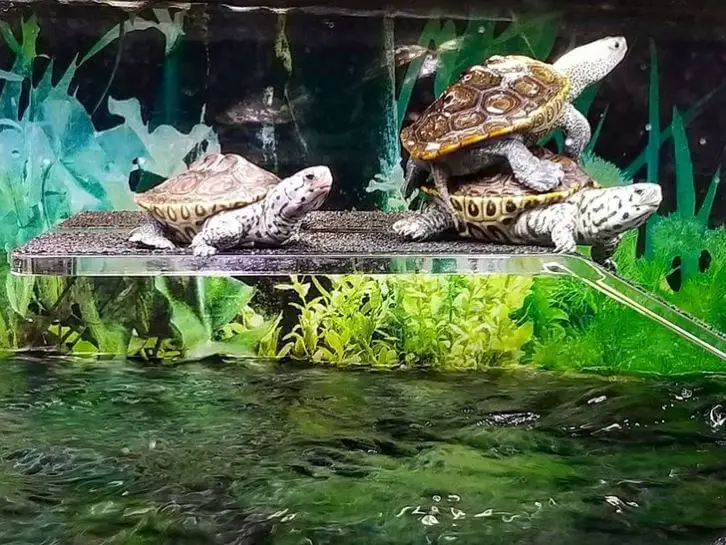
1. Full-spectrum Fluorescent Lights
Full-spectrum fluorescent lights also work well for turtles and come with their own set of benefits. They provide good lighting options at affordable rates and emit a very less amount of heat when compared to mercury vapor lights.
They not only help in increasing the overall activity level but also enhance their immunity system by providing them with vitamin D3, which is vital for calcium absorption so that the turtle’s bones and shells can grow properly.
Moreover, most of these lights come with a built-in timer system, which allows you to set the time for them with ease.
The only drawback is that they cannot be used in an outdoor pond as they do not have any protective gear against rain or water damage.
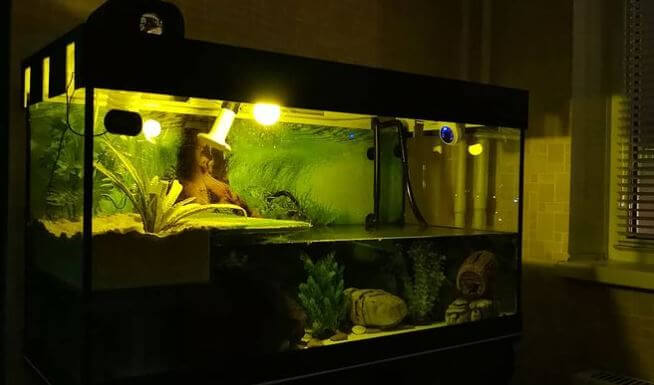
2. Mercury Vapor Lights
Mercury vapor lights are by far the best option as far as setting up your terrarium and providing good lighting options go.
They emit a very little amount of heat and there is no chance of short circuits even if water enters the light bulb area due to heavy rains or storms outside.
But one important thing to remember here is that mercury vapor lights must never be used with an open-top tank as, unlike fluorescent bulbs, these bulbs need to be placed inside a protective bulb guard.
Moreover, mercury vapor lights are the costliest option, but you will get good lighting options in one go.
One thing you must consider while deciding on your choice of light is that if the turtle tank is made of glass, then it should have shatterproof bulbs.
Also, choosing an appropriate wattage for the bulb, which does not exceed more than 40 watts for fluorescent and 60 watts for mercury vapor lights, can ensure safety, too.
Apart from all these things, make sure you choose a light source that has proper UVB rays emission.
Else, even after spending money on expensive full-spectrum lights, your turtles may still develop health problems like metabolic bone disease (MBD), which is quite common in captive turtles.
How to Set Up a Turtle Tank Properly?
A turtle tank needs to be properly set up.
There are many types of tanks available in the market (for example, large glass aquariums), which can make keeping turtles very convenient, but they are also quite expensive.
A preferable choice would be a smaller plastic tank with proper dimensions as it is easier to maintain and does not cost much either.
Given below are some important things you should keep in your mind while making your purchase decision:
- No matter how big or small your tank is, try to keep it as simple as possible by avoiding too many objects inside it.
- Make sure all the items that you place inside the terrarium such as plants, artificial rocks, etc. have smooth surfaces so that there is no chance of injury for your turtle due to any sharp edges.
- The size of the tank is another factor that you should consider when you are making your purchase decision. While it may be difficult for you to believe but an adult turtle can easily fill up a 25-gallon tank within no time so do not buy something too small either in width or height.
As far as filter selection goes, try to opt for a model that has multiple filtration options instead of just one mechanism because there may be times when you have to use different filtration methods based on the current situation at home.
For example, if your house gets very dirty during winter, then using a biological filter may not be possible initially until the air quality improves.
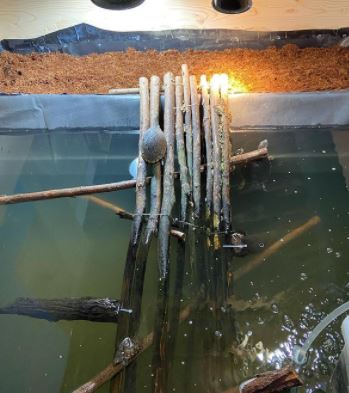
What Makes a Good Turtle Tank Filter?
The size of the filter is also an important factor as you do not want to exceed filtration capacity, which can cause your tank’s water to turn dirty too quickly, and then be able to clean them on time becomes impossible.
Filters come in different sizes depending on their flow rates, so choose one that ch is suitable for your tank size and has a higher flow rate than what you actually need.
The last thing you want is your turtles living in dirty and smelly water because the filter cannot handle the load put on it by the inhabitants of the terrarium.
We highly recommend that you read reviews about various filters available out there before making any purchase decision.
You may be thinking that turtles do not require any heating as they live in water and water has its own temperature, but this is not true as the surrounding air temperature plays a huge role in regulating your turtle’s body temperature.
While they would survive being kept at room temperatures, there are chances of them developing certain problems over a period of time due to their inability to regulate their body heat properly.
Also, remember that there have been many cases where pet turtles have died due to being exposed to sudden changes in outdoor temperatures, so it is better if you avoid keeping your pets outside for long periods of time.
Proper environmental conditions are required in order to keep turtles healthy.
It is your responsibility to make sure that they stay warm when the outdoor temperature drops and also do not experience sudden changes during hot summer days.
The best way of checking the tank’s water is by using a high-quality thermometer, which can be found online at very affordable prices.
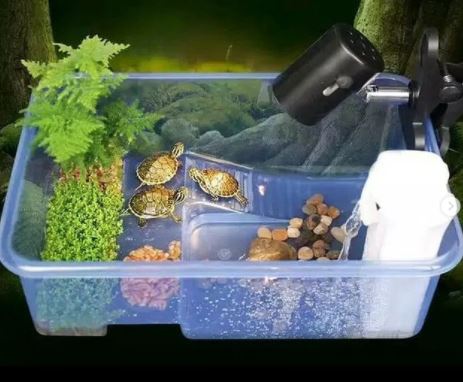
What Turtle Lighting Options Are Available?
Now, let us take a look at what lighting options are available today when it comes to turtle tanks.
As you can see, there is quite some variety when it comes to this topic but our advice would be to stick with just one type of lighting system instead of trying out different types simultaneously or switching between them frequently.
You will have too many things to monitor when you do that, which can cause stress.
UVB lighting is undoubtedly the best option for indoor turtles as it allows you to provide them with the necessary vitamin D3 that they require for their bones and also does not interfere with any other kind of filtration system.
If your tank does not come with a built-in UVB emitting light, then you should go for an external one instead so that there are no chances of your turtle getting exposed to direct sunlight.
While full spectrum lights do serve the purpose, they are becoming more difficult to find these days because most people have become aware of how harmful UVA rays can be, especially when combined with heat lamps.
There are some good options available in this category but they often come integrated into complete lighting systems such as T-Rex Active UVB and ReptiSun 10.0 Compact Fluorescent Lamps.
UV lighting is only required if you plan on keeping live plants in the tank because it helps them to grow better through photosynthesis.
We all know that turtles love eating green stuff, so this can be a great way of motivating and training your pets to keep their enclosures cleaner and healthier for them to live in.
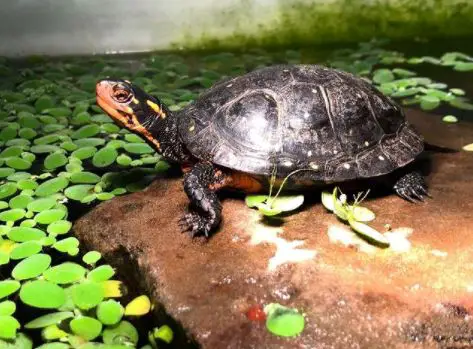
What Should Be in a Turtle’s Basking Area?
The basking area is a part of the turtle’s habitat where she can dry off and get warm.
The basking area includes a place to bask (sitting in the light to absorb heat) as well as a place to hide should she feel stressed or threatened, which often coincides with needing a warm, secure place.
Most aquatic turtles will bask on a dry surface near their watery home.
Logs, rocks, stones, driftwood… basically, anything that won’t dissolve in the turtle tank water that cannot be easily moved by your turtle (no plastic) can be used for both basking and hiding places.
Reptile lights are usually used to provide some sort of basking platform under which your turtle can sit comfortably while absorbing heat and light.
It’s also possible, depending on your turtle breed and species, to provide a basking platform over the tank’s water for aquatic turtles to sit comfortably under.
How to Choose a Basking Light for Turtles?
Reptile lights can be purchased at most pet stores pretty cheaply.
Make sure you get one that fits within your budget and is powerful enough to meet your lighting needs (we’re talking about providing warmth and UVB here) as well as considering ease of use and safety if you have children or pets in the home.
Some reptile lights are very bright and present an obvious danger should they be bumped into by someone not expecting them (or vice versa).
Some take time to warm up before getting super bright, but others don’t.
Some provide UVB, but others do not.
Some come with a clamp to attach them to the side of the tank, but some hang from the hood and require you to supply your own clamps or hooks.
The most important thing is that you get one that will suit your needs and that is easy enough for you to use safely while still providing what your turtle needs.
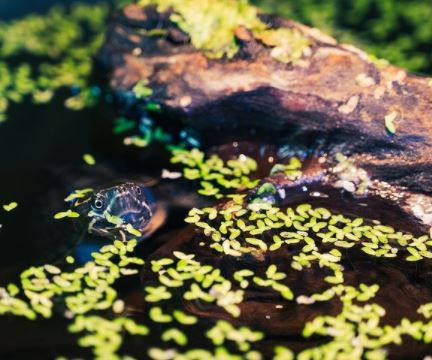
How to Choose Turtle Hides?
A lot of aquarium-type hides are too wide for turtles. They can walk out! It’s best to find something narrow enough in width but tall enough for your turtle to fit comfortably.
An upside-down flowerpot works well if you cut a few air holes into it. You can also buy good plastic reptile hides, which work nicely if you have the budget for them.
Another thing to keep in mind is that your turtle may need more than one hide, depending on the size of their tank and how many different temperatures/surfaces they can access.
A turtle who spends time both at the surface of the water AND lower down near the bottom needs two hides: one for each area.
After all, you wouldn’t want to spend your day sitting around half-submerged with nowhere dry to rest, or vice versa.
Turtles are smart about these things!
If you give them only one place to sit (a large flat rock halfway up their tank for example), they will choose it as their basking spot and use it ALL THE TIME rather than sitting on it just before an occasional feeding time or when they wake up from a long winter’s nap.

How to Find the Right Basking Surface for Turtles?
There are many different surfaces turtles like to bask on depending on the species and their natural habitat, including plants (live or fake), rocks and stones (heated by the basking bulb or not), and pieces of driftwood.
Most turtle owners prefer to use one safe surface that can hold up to the turtle’s chewing habits over trying several different surfaces that may fall apart in the tank water.
If you do decide to go with something like a plant, make sure it is either protected under the basking light so it won’t become damaged by being too close, or isn’t near enough to be burned by the basking light, or that it is actually designed to be placed in the water.
You don’t want your turtle to get sick by accidentally eating some of the plants in his tank!
As far as using rocks and stones with heat elements goes, this can be OK if you are very careful about not letting your turtles chew them.
But they do present danger since there’s nothing stopping your turtle from nimbly climbing up onto any rock or stone surface and touching its nose to the heated element.
We recommend heating natural surfaces like driftwood with your basking bulb instead of artificial rocks or stones for this reason.
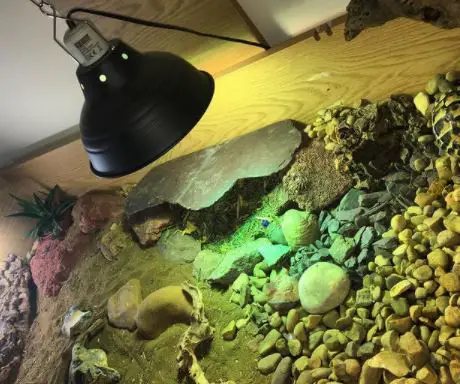
How Long Should a Turtle Basking Light Be On?
It’s recommended that you leave the lights on for 8-10 hours a day. Turn them off at night for 10-12 hours. You can do this by using a timer.
Turtles are cold-blooded, so they rely on their environment to regulate their body temperature.
Basking lights help them to absorb heat and light. This helps in digestion and skin shedding. Without light, they can’t process their food properly and can get sick.
If you plan on getting a turtle during the winter months, you need to let them bask for less time so that they don’t get too hot or dehydrated.
Conclusion
How many watts for turtle basking are ideal?
Turtles are cold-blooded, meaning that they cannot regulate their body temperature.
When it’s cold outside, turtles need to bask in the sun or warmer objects to stay warm enough.
If you want your turtle to be happy and healthy during the winter months, make sure they have access to a heat lamp or other warmth source for at least 8 hours per day.
Be careful not to let them overheat, though! The basking spot should ideally be around 100 degrees Fahrenheit (38 degrees Celsius).
Key points of consideration for how many watts for turtle basking:
1. Consider the Habitat:
- Turtle Species: Different turtle species have varying temperature requirements based on their natural habitat. Research your specific turtle species to determine its ideal basking temperature.
2. Factors Influencing Wattage:
- Enclosure Size: The size of the tank or enclosure impacts the heat distribution and the necessary wattage of the basking lamp.
- Distance from Basking Spot: The distance between the basking area and the lamp influences the temperature achieved at the basking site.
3. General Guidelines:
- Typical Wattage Range: Basking lamps for turtles commonly range between 50 to 150 watts, depending on the enclosure size, species, and ambient room temperature.
- Incandescent Bulbs: A 50 to 75-watt incandescent bulb may suffice for smaller enclosures or species requiring lower temperatures.
- Halogen or Ceramic Heat Emitters: Larger enclosures or species needing higher temperatures might necessitate 100 to 150-watt bulbs or heat emitters.
4. Thermoregulation Requirements:
- Temperature Gradient: Ensure a thermal gradient within the enclosure, with the basking spot being the warmest area, reaching temperatures specific to your turtle’s needs.
- Basking Temperature: Most aquatic turtles prefer a basking spot temperature ranging between 85°F to 95°F (29°C to 35°C).
5. Monitoring and Adjustments:
- Use Thermometers: Install reliable thermometers to monitor the temperature accurately within the basking area and adjust the wattage accordingly.
- Observation: Watch your turtle’s behavior; if it consistently avoids or rarely uses the basking area, it might indicate the temperature is too high or low.
6. Environmental Conditions:
- Room Temperature: Ambient room temperature also influences the enclosure’s overall heat levels, impacting the wattage needed for the basking area.
7. Professional Advice:
- Consulting Experts: Seek guidance from experienced reptile veterinarians or herpetologists for precise wattage recommendations tailored to your turtle’s species and habitat setup.
Ensuring an appropriate basking area with the correct wattage is crucial for your turtle’s thermoregulation and overall well-being. Careful consideration of wattage, temperature gradients, and regular monitoring will create a comfortable and healthy environment for your pet turtle.
Further Reading:
- 7 Best Plants for Turtle Tank
- 5 Best Turtle Basking Platforms
- How Much Water Should Be in a Baby Turtle Tank?
- How to Clean River Rocks for Turtle Tanks?
- How to Keep Turtle Aquarium From Smelling?

